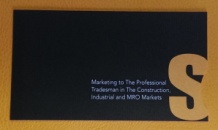by tradesmeninsights | Oct 25, 2016 | Marketing Tips
By Chris Ilcin, Account Superintendent, Sonnhalter
I’m addicted to TEDTalks. If you don’t know what they are, here’s a primer from their website.
“TED is a nonprofit devoted to spreading ideas, usually in the form of short, powerful talks (18 minutes or less). TED began in 1984 as a conference where Technology, Entertainment and Design converged, and today covers almost all topics — from science to business to global issues — in more than 100 languages. Meanwhile, independently run TEDx events help share ideas in communities around the world.”
Part of this initiative is a weekly radio program that takes a look at a theme through insights from several TEDTalks, called the TED Radio Hour.
 They recently had an episode dedicated to Value, Brand and how our brains process the “worth” of something. Turns out, it’s all way more subjective that you may think.
They recently had an episode dedicated to Value, Brand and how our brains process the “worth” of something. Turns out, it’s all way more subjective that you may think.
Every day you assign value to a thousand things without ever thinking about it. How? What biases come into play, and what can nudge those biases so much that you notice that you’re being manipulated? And can you even use that realization to your benefit?
And that’s the line great content marketing should straddle. Yes, at the end of the day you are trying to push the customer towards your product, and a consumer should realize that as well. But if the content itself still provides useful information, or is packaged in a way that acknowledges that transaction, it can still be beneficial.
(more…)
by tradesmeninsights | Apr 22, 2015 | Marketing Tips, Marketing Tools, Marketing Trends, Social Marketing, Traditional Marketing
By Chris Ilcin, Account Superintendent at Sonnhalter

Photo Courtesy of Osborn
Do your employees know where your products are used? Do they know the applications the parts they make make possible? Are they aware of the history and critical nature of your company? There are many simple, cost-effective ways to increase productivity and morale by implementing a program that lets them know.
To land new business, you’re always told to “Tell Your Story” well. It’s just as important to tell it internally. Why?
• It makes employees feel like part of the plan – Let them see the big picture and where you as a company fit into it
• It helps them see the long view, not just their day-to-day part in it – There’s a plan, not just a daily task
• It builds internal networks – If Engineering tells their story to Customer Service, everyone sees people and faces, not silos
• It allows them to be brand ambassadors – If they know the story you want told, then that’s the story that gets re-told
So how do you reach them? That’s the easiest part—the same way you reach new customers:
• Host an Employee Open House – Let them show off to their kids, and see what goes on in other departments
• Giving a tour of your facility? Engage employees – Don’t treat them like an extension of the machine they’re working, but have them describe what they do, and the cost savings, quality assurance or other aspect of their work
• Start an internal newsletter – It’s a great place to either post external press releases, or develop case studies for outside use
• Cover the Walls – Advertising blown up as posters reinforce your brand internally and when guests tour your facility
• Let them hear & be heard – Have a quarterly or monthly meeting of non-managerial representatives from every department, and allow for an open exchange or ideas, complaints and stories
• Highlight your company’s history whenever possible – Old ads, press clippings or photos give a sense of pride and place
• Have a mission statement – And stress it internally. Print it on business cards, coffee cups in the vending machines; anywhere it will be seen regularly
You don’t need to be told that Manufacturing has gotten a bad rap. For years it’s been the butt of jokes, seen as a “dead end” and been declared all but extinct in this country by countless talking heads.
Well those people are wrong. And the house they left to get into the car they drove to the studio where they made their comments is testament to it. And it’s time your employees knew that too.
I once heard a really cool story about the Gateway Arch in St. Louis. It has a unique elevator that kind of side-steps its way up to the top of the arch. Well if you look into the arch, instead of out at the view, along the way you’ll see large welder-generators. They’ve been there since the Arch was built in the mid 60’s. Because of the way the arch was made, it was impossible to move them, so they just left them, placed another (which also got left behind) and kept building.
As a former employee of that welding manufacturer, I think that’s fascinating, and if I could ever get over my nagging fear of heights, it would be the best part of the trip up. To know that something that was made in the same building I worked in was instrumental in a project like that, it just boggles the mind. All the “ordinary” people, doing their “ordinary” job at factories all across the country added up to a modern marvel like that. Inspire that sense of awe in your employees, and they’ll help do the heavy lifting of establishing a brand.
by tradesmeninsights | Oct 24, 2013 | Marketing Tips
Today we have a post from PR Engineer Rachel Kerstetter sharing some thoughts on business cards.
When I first started at Sonnhalter, the day that I was issued my own business cards was a good day. It was exciting to have new cards with my shiny new title, but a comment made by a fellow PR professional lead me to wonder if business cards still matter.
Last fall, I was volunteering at an event for students and was placed at a table with another PR professional. At the end of the lunch, I gave the students my card and encouraged them to connect with me on LinkedIn. The other professional said, “I never bring cards anywhere with me since anyone can just find me on LinkedIn anyway.”
Her comments got me thinking about my business cards and wondering if they were still valuable. My observations and experiences over the past year have brought me to the conclusion that business cards are still relevant.
Business cards:
- Enforce your branding, with your logo, corporate colors, tagline and job title.

Sonnhalter’s branding is apparent on our business cards
- Make you easy to find by spelling out your contact information, and in my case, my long last name.
- Stick around. Often your card will find its way into someone’s pocket, and at the end of the day your card will end up being added to their existing business card collection.
- Get shared. How many times have you been asked for another card because someone gave away the only one you had given them? How many times has a friend or colleague handed you someone’s card and recommended you check them out?
One small piece of cardstock can go pretty far in beginning professional relationships.
by tradesmeninsights | Oct 24, 2012 | Marketing Tips, Social Marketing, Traditional Marketing
The correct answer in my mind is today. We all get caught up in the day-to-day to do list and putting out the most recent fire, but we should be aware of our brand daily.
Branding is about your whole organization, from the way you answer the phones, to the attitudes of your CSRs. It’s about a culture, things that are out of the control of the marketing department. Yes, marketing can control the look and feel of promotional materials, but once we’ve hooked a prospect, what happens when they contact the company and actually talk to a human being?
Heidi Cohen, in her post, Why Brands Matter (And Size Doesn’t), highlights several attributes we can all use to help in our long-term objectives.
Here are some highlights:
- Are you providing value to your customers – understand your target markets and their needs
- Are you relevant to your customers – be where your customers are
- Extend your brand beyond the product – provide useful info at every step of the purchasing process
- Have a brand personality – needs to be consistent in all dealings with customers
- Creating a trusting relationship – earn your reputation every day. Don’t assume anything.
What’s your company doing on a daily basis to make sure your brand is living up to expectations?
by tradesmeninsights | Apr 17, 2009 | Marketing Tips
 B-to-B marketers are so busy pushing out messages using traditional methods to promote their brand that they sometimes forget about the strength of social media to self-identify themselves by searching for solutions or information on the Internet.
B-to-B marketers are so busy pushing out messages using traditional methods to promote their brand that they sometimes forget about the strength of social media to self-identify themselves by searching for solutions or information on the Internet.
Social Media is the most powerful set of tools for branding that has ever existed for connecting with customers on an emotional level.
The brand that a marketer is selling is not merely a logo, a package or a sign on a wall. A brand is not what you want it to be or what your ad says it is. A brand is not even the definition you give to it.
Quite simply, a brand is how your audience feels about you. It’s what they say about you when not encumbered by advertising promotion. Or unencumbered by the paid media around you. So when your “friend” on Facebook, Twitter or Linkedin says they just found the best hot dog in town, you believe them. Much more so than a TV spot.
What better way to receive an endorsement for a product than to get that endorsement from a trusted friend? And that’s what social media is all about.
It’s a simple idea and it works.

 They recently had an episode dedicated to Value, Brand and how our brains process the “worth” of something. Turns out, it’s all way more subjective that you may think.
They recently had an episode dedicated to Value, Brand and how our brains process the “worth” of something. Turns out, it’s all way more subjective that you may think.


 B-to-B marketers are so busy pushing out messages using traditional methods to promote their brand that they sometimes forget about the strength of social media to self-identify themselves by searching for solutions or information on the Internet.
B-to-B marketers are so busy pushing out messages using traditional methods to promote their brand that they sometimes forget about the strength of social media to self-identify themselves by searching for solutions or information on the Internet.